#macrolichens
Explore tagged Tumblr posts
Note
Did you see that paper about the Bryoria fremontii/tortuosa lichens? How they're genetically identical, but the researchers found basidiomycetes yeast embedded in the cortex of the tortuosa samples? I'm never not thinking about it.
If you mean "Basidiomycete yeasts in the cortex of ascomycete macrolichens" then yes indeed. We assign it for our class, and so my lab group has picked it apart a bunch of times over. I think the research is cool, but I think they are taking too big a swing with the whole idea that we need to reconceptualize the lichen symbiosis. They found a cool phenomenon in one lichen species, and they brought attention to the importance of considering comensalistic and symbiotic associations of microorganisms, but it's too much to assume this is going on all the time (and no one else has been able to find similar patterns so . . . )
28 notes
·
View notes
Text
oh and my dad got me the new macrolichens in Ontario book from the library which is super pog and the photos are fantastic!! so i am hoping to do more lichen-related things as well
#original#i already made a zine about local lichens#i made a page on my website about local lichens#i want to move forward with lichen art projects like my linocut and embroideries and drawings#the book isn’t suitable for me to scan it or i would! hopefully it’ll be on libgen or something soon
0 notes
Photo
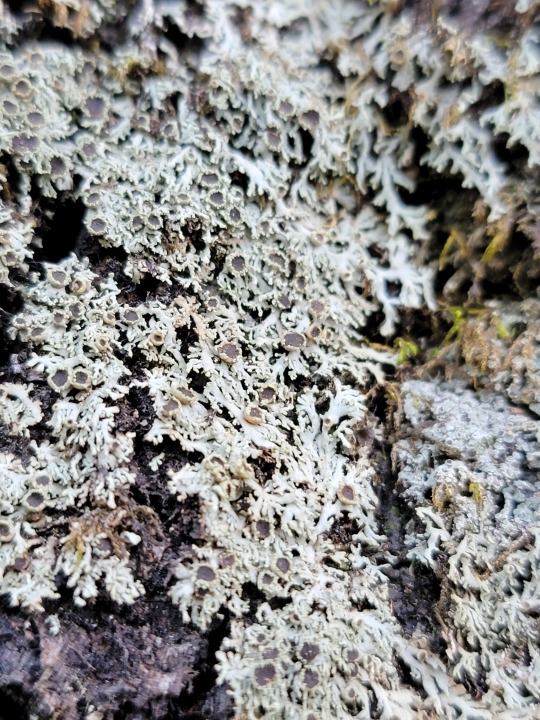

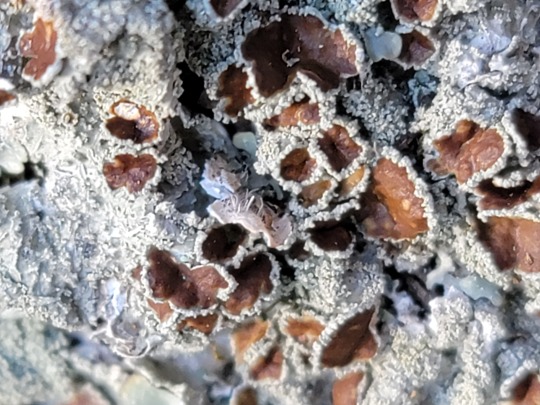


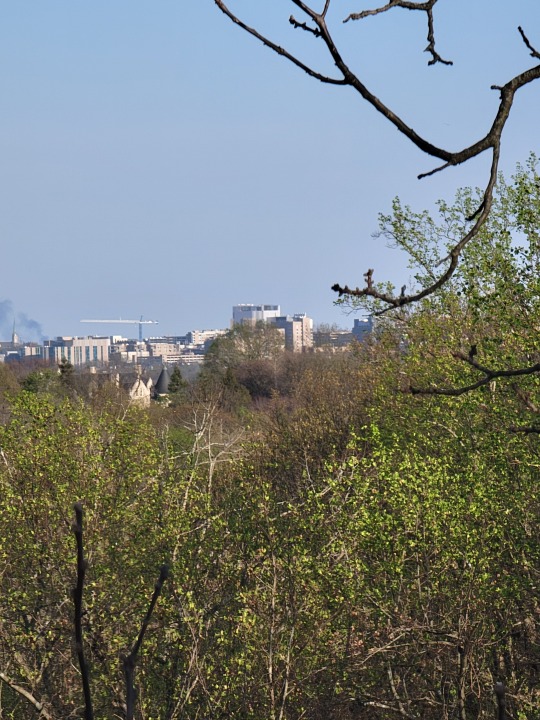
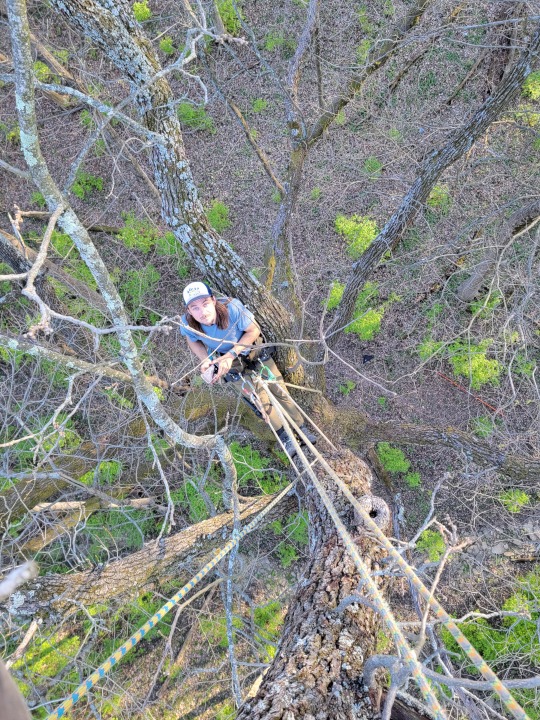

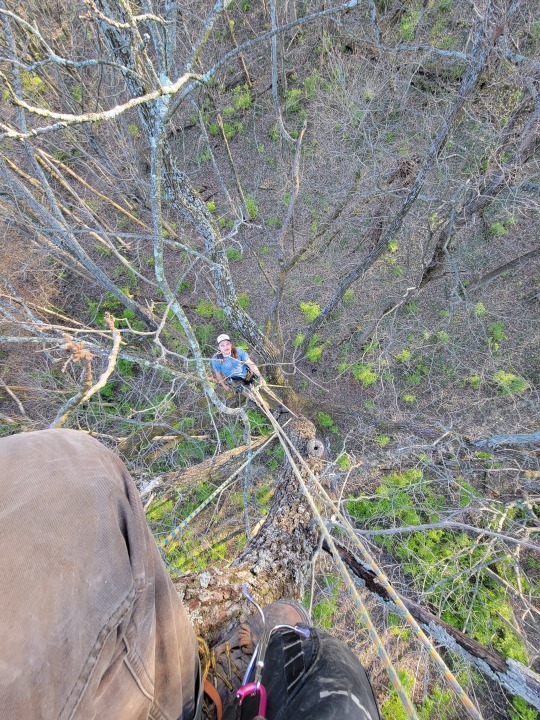
two dope ass macrolichens I got very excited about in a walnut tree last spring (55 dbh walnut 115 feet top to bottom which is the biggest black walnut i’ve ever climbed hidden in this valley in Mt. Airy forest in Cincinnati. )
I was excited because I don’t see these in Cincinnati though they are common in southern Ohio despite the fact. Really uncommon in city regions due to heat island issues low rainfall compared to past rain due to deforestation and climate change, and the classic air pollution problem. We got lucky, this walnut was in a valley and surrounded by forest, the tips were caked in one of these though the other was just pure luck to begin with. My first time seeing this species out of high quality habitat like Adams county Ohio or RRG region Kentucky.
Top is my favorite lichen, a somewhat variable species that appears on moss thats on dolomite, or moss thats on trees.
Shaggy-fringe Lichen, like even the apothecia are fringed!, when hydrated the thallus is an emerald green, its puffy sometimes and looks like a fringy tube lichen and sometimes the thallus looks thin like this picture, Anaptychia palmulata
Moondust Speckled Lichen with its dope apothecia large and in charge, Punctelia caseana
#anaptychia#anaptychia palmulata#punctelia#punctelia caseana#lichen#mycology#botany#plantblr#macrolichens#macrolichen#ohio#danny#arborculture
18 notes
·
View notes
Photo
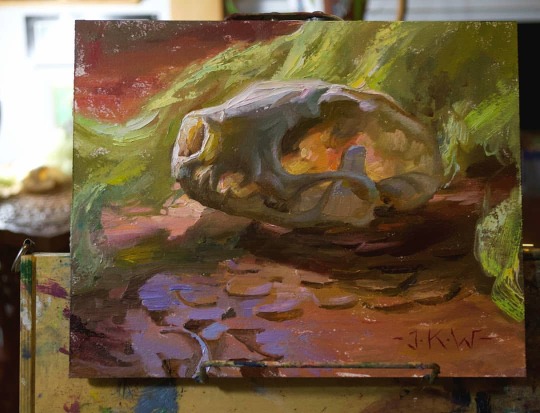
Day 20 #stradaeasel challenge I've always admired nicely painted backlit scenes, but haven't made that many myself - today I thought it was time I changed that! Here's a glowing mink skull to bring you warmth and good tidings! #painting #art #stilllife #skull #vultureculture #oilpainting ##raymarpanel #backlit #dailypainting #allaprima #artcollector #artforsale #pacificnorthwest #macrolichen #instaart #stradaeaselchallenge2021 @strada.easel https://www.instagram.com/p/CKTEyJ9DnYs/?igshid=5jbkwx3b1bcz
#stradaeasel#painting#art#stilllife#skull#vultureculture#oilpainting#raymarpanel#backlit#dailypainting#allaprima#artcollector#artforsale#pacificnorthwest#macrolichen#instaart#stradaeaselchallenge2021
12 notes
·
View notes
Photo




lichen on a tree
Catskill Mts NY
10 notes
·
View notes
Photo

'Watch out! It's very, very fragile! This is a leafy "macrolichen", a sort of moss that is a symbiose between an algea and a fungi. Beautiful right?' . #pacoandfrancisco #piecesofnature #macrolichen #nature #moss #design #woodworking #tinyworlds #shousugiban #pacokamil
#piecesofnature#macrolichen#nature#moss#woodworking#design#tinyworlds#pacoandfrancisco#shousugiban#pacokamil
1 note
·
View note
Text
Líquenes: casa de muchos
No es uno ¡son dos! ¿tal vez tres? ¿más?

Los líquenes son en esencia organismos compuestos, creaturas simbióticas. Tradicionalmente, se les definía como integrados por un micobionte (un hongo) y un fotobionte (algún organismo que haga fotosíntesis: como las algas verdes o cianobacterias). Sin embargo, estudios realizados durante la última década han cambiado la forma en que vemos los líquenes, y dejado en claro que se tratan de algo más complejo. Un pequeño y auto-contenido ecosistema.
Por ejemplo, en un estudio realizado en 2016, identificaron la presencia extendida de levaduras (otro hongo! pero unicelular) en un par de líquenes de Norteamérica. Estas levaduras, en el caso de las dos especies de liquen (Bryoria spp.) fueron la diferencia clave, que explicaba la hasta entonces inexplicada coloración distinta entre ambas especies. Es decir, un tercer, y hasta entonces anónimo integrante, estaba afectando directamente las características físicas del liquen.
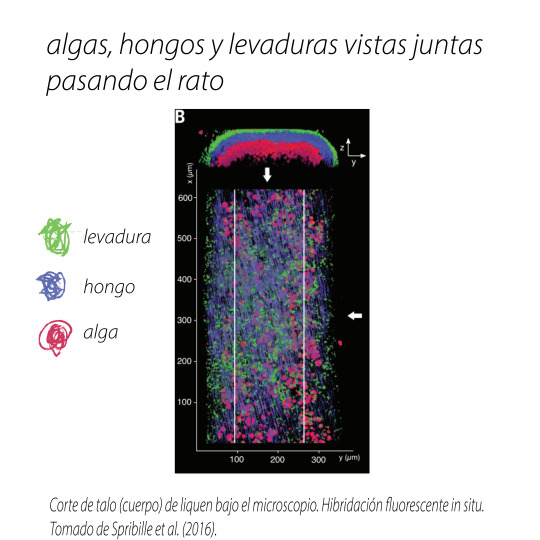
Ese es solo un ejemplo. Además de levaduras, hay muchos otros microorganismos asociados a los líquenes: se han encontrado bacterias, protistas e incluso virus en ellos. ¿Qué tanto son parte de esta simbiosis?
Algunas bacterias sirven en este pequeño ecosistema como fijadoras de nitrógeno, ciertas bacterias se encuentran solo en la superficie o aprovechan la humedad y sombra debajo del talo. La estructura, forma y función de los líquenes podría estar dictada por estos discretos participantes ¡pero aún no lo sabemos!
A continuación algunos líquenes vistos en Oaxaca:

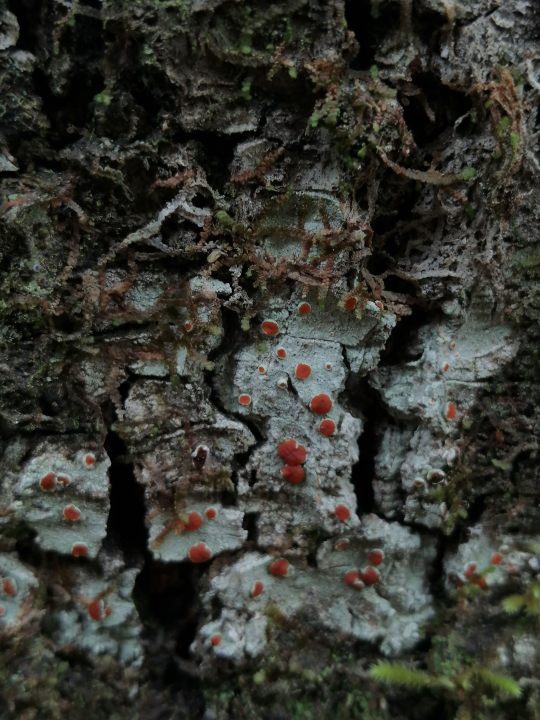
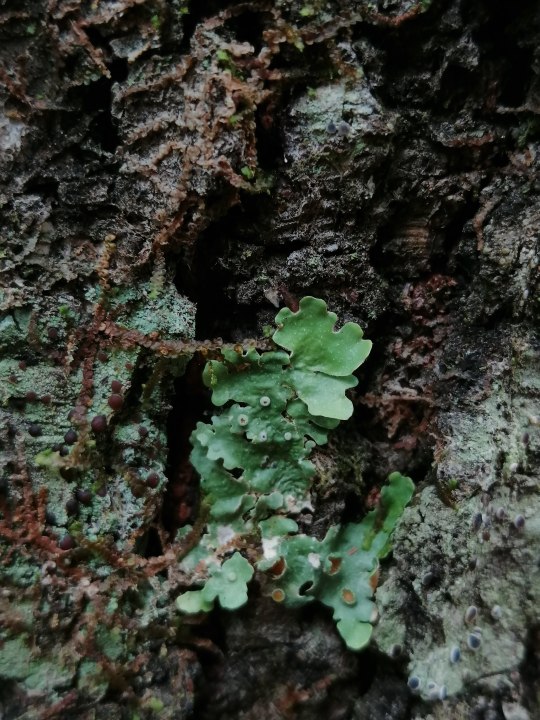
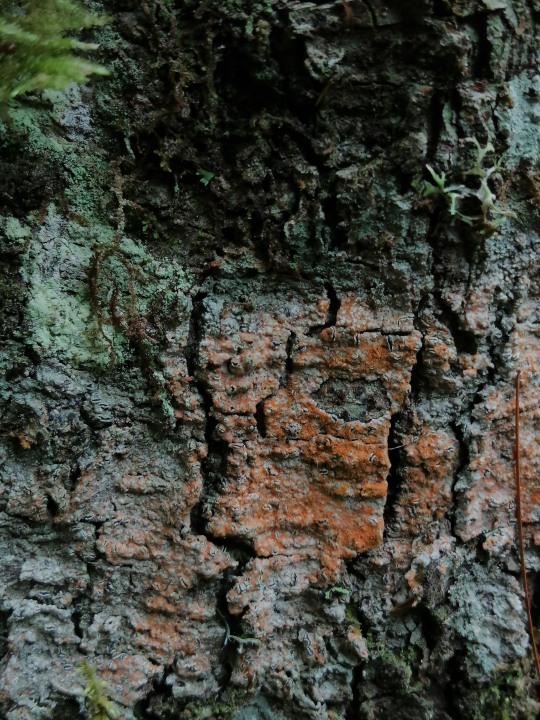

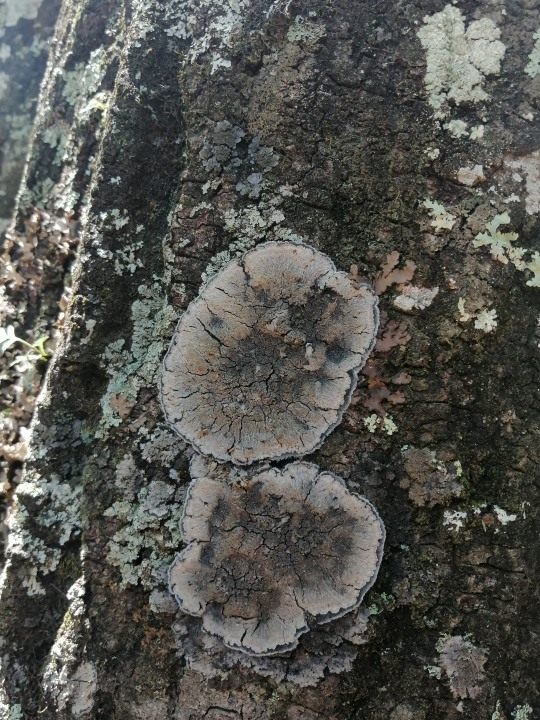
Literatura consultada
Spribille, T., Tuovinen, V., Resl, P., Vanderpool, D., Wolinski, H., Aime, M. C., ... & McCutcheon, J. P. (2016). Basidiomycete yeasts in the cortex of ascomycete macrolichens. Science, 353(6298), 488-492.
Morillas, L.; Roales, J.; Cruz, C.; Munzi, S. Lichen as Multipartner Symbiotic Relationships. Encyclopedia 2022, 2, 1421–1431. https://doi.org/ 10.3390/encyclopedia2030096
Nash, T. H. (Ed.). (2008). Lichen biology. Cambridge University Press
2 notes
·
View notes
Text
More on how the inland temperate rainforest region of the interior Pacific Northwest hosts one of the single most biodiverse epiphytic lichen communities in the world, with higher arboreal lichen biodiversity than the coastal temperate rainforest.



An old-growth cedar stand typical of inland temperate rainforest, at BC’s Ancient Forest / Chun t’oh Whudujut Provincial Park. [Photos from Ancient Forest Alliance.]

“Smoker’s lung lichen” (Lobaria reigera) is a rare arboreal lichen that is mostly limited to the temperate rainforests of the Great Bear Rainforest and Pacific coastline, but some isolated populations are also found in the inland temperate rainforest region. [Photo by P. Bartemucci.]
Since 2002, the Valhalla Wilderness Society has sponsored research on inland rainforest lichens by lichenologist Toby Spribille, formerly based at the University of Gottingen, Germany. Spribille has worked closely with BC lichenologists Curtis Bjork and Trevor Goward. They have found that the inland temperate rainforests contain one of the richest tree lichen floras in the world -- richer than BC’s coastal temperate rainforest. Spribille, Bjork, and Goward found more species of lichens in the Incomappleux Valley than tree, shrub, herb, grass and moss species combined. [Source: Valhalla Wilderness Society, 2008.]
Temperate rainforest ecosystems have been widely recognized as a major repository for biodiversity, particularly for organisms that live within forest canopies. In western North America, coastal temperate rainforest ecosystems have been the focus of increased attention in recent years. [...] However, in British Columbia (B.C.) a second major temperate rainforest ecosystem is found on the windward slopes of interior mountain ranges. This inland temperate rainforest (ITR) has many unique characteristics, including globally significant assemblages of canopy lichens and mosses. Some 40% of oceanic epiphytic macrolichens found in Pacific coastal rain forests also occur in these inland rainforests. Among oceanic epiphytic species found in the inland rainforest are the hanging moss (Antitrichia curtipendula) and lichen genera such as Chaenotheca, Chaenothecopsis, Collema, Fuscopannaria, Lichinodium, Lobaria, Nephroma, Parmeliella, Polychidium, Sphaerophorus, and Sticta conclude that “conifer forests of intermontane British Columbia support at least 31 cyanolichen species -- one of the richest epiphytic cyanolichen assemblages in the world”. They suggest that maximum cyanolichen diversity is associated with the co-occurrence of nutrient-rich sites in lowland old-growth inland rainforest sites. [Source: “Predicting canopy macrolichen diversity and abundance within old-growth inland temperate rainforest.” Forest Ecology and Management, 2009.]
We report our initial findings of 39 lichen taxa, including several rare species and cyanolichens, which may be especially sensitive to climate. […] Some of the world’s most famous temperate rainforests occur along the west coast of North America. A lesser known, but equally unique ecosystem is the inland temperate rainforest (ITR), which is predominantly located in British Columbia between 50° and 54°N. The ITR shares many characteristics with its coastal counterparts, including large diameter western redcedar (Thuja plicata), some speculated to be over 1000 years old (Radies et al. 2009), and a dense understorey of devil’s club (Oplopanax horridus). This ecosystem provides important habitat for many species, including the threatened mountain ecotype of woodland caribou, and many disjunct populations of characteristically coastal lichen species. Old-growth coniferous stands in the ITR support exceptionally rich epiphytic lichen communities, especially cyanolichens lichens that have a cyanobacterial photobiont as one of their symbiotic partners. [Source: “A Framework for Climate Monitoring with Lichens in British Columbia’s Inland Temperate Rainforest.” Journal of Ecosystems and Management.]


Biatora aureolepra, an arboreal lichen species formally described in 2009, from the inland temperate rainforest. Photo from: “Contributions to an epiphytic lichen flora of northwest North America: Eight new species from British Columbia inland rain forests” (2009).

Coral lichen (Sphaerophorus venerabilis), an arboreal lichen from the inland temperate rainforest that requires the presence of old-growth cedar-hemlock stands. [Photo by David Moskowitz.]
817 notes
·
View notes
Photo
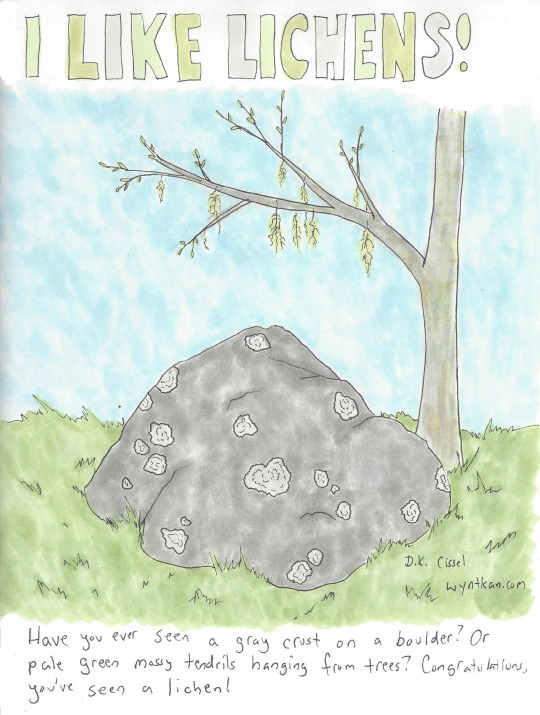

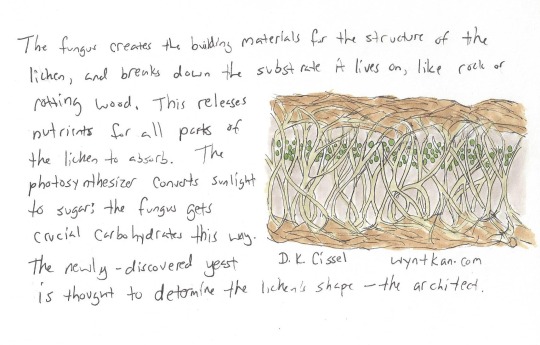
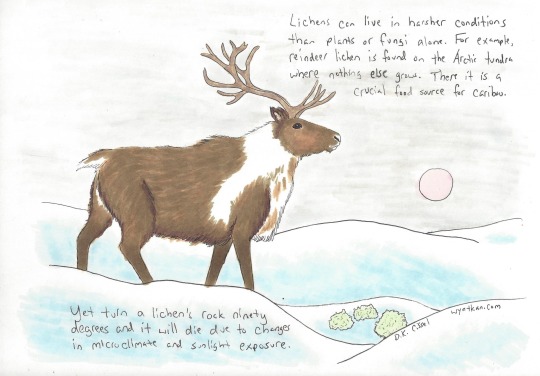
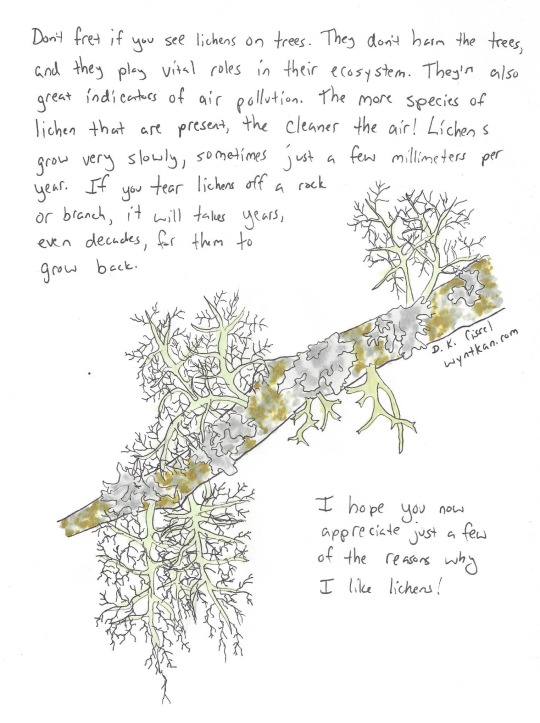
Lichens are incredible beings, as far as I'm concerned, and some of the most misunderstood and overlooked as well. I appreciate their complexity and tenacity, and I also think they're pretty, too! I'm very lucky that there's a lot of lichen diversity where I live; I am in a place with several microbiomes, and so it's neat seeing which species I find in each. Plus it's a good sign that the air here is clean, too.
I do have to say that as a citizen-level naturalist rather than a lichenologist, I sometimes feel a bit overwhelmed by how some lichens are so similar that you basically need a microscope to tell two species apart. I once went out into the woods with my copy of Macrolichens of the Pacific Northwest, intent on identifying all the lichens I found, and while I was able to nail down some, there were others that I just wasn't able to get a species-level ID on. (And then I uploaded pictures to iNaturalist and let the experts tell me what I was missing!)
Admittedly, if I had infinite amounts of time and money and could go back to school (again), I'd strongly consider mycology with an emphasis on lichenology. But then again I'm also tempted by the bryophyte end of the botany pool. And marine biology is pretty neat, too. Also restoration ecology...you know, maybe it's better that I just opted to be a Master Naturalist. I don't have to choose a specialty, and it didn't cost nearly as much!
Species portrayed: Questionable rock-frog (Xanthoparmelia cumberlandia), old man's beard (Usnea spp.), red alder (Alnus rubra), pixie cup lichen (Cladonia asahinae), reindeer moss (Cladonia rangiferina), caribou (Rangifer tarandus), hammered shield lichen (Parmelia sulcata), oakmoss (Evernia prunastri), assorted microlichens
159 notes
·
View notes
Note
Why do academic books gotta be so pricey I'm dying over here. 80 gotdamn dollars for a regional macrolichen guide, and 169 for a book about lichen substrates and that's secondhand :'0
Capitalism.
But really I don't understand the price tags on all scientific and academic publishing. The prices are so ridiculously inflated and I don't know who benefits, but I know that it inconveniences most people--scientists, students, and anyone interested in this stuff.
31 notes
·
View notes
Photo
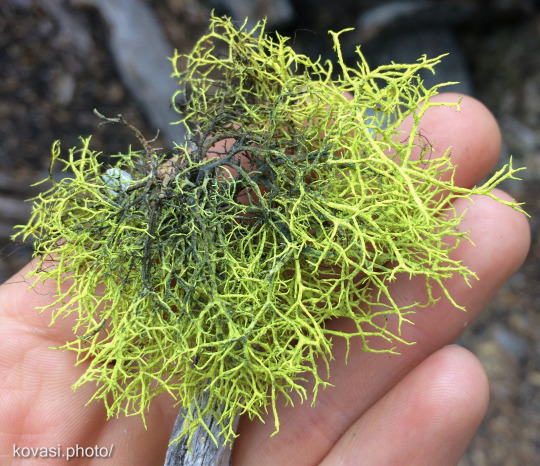
Bajpai, Rajesh, Vertika Shukla, D. Upreti, and K. Semwal. "Selection of Suitable Lichen Bioindicator Species for Monitoring Climatic Variability in the Himalaya." Environmental Science and Pollution Research 21.19 (2014): 11380-1394. Web.
This study taking place in the Govind Wildlife Sanctuary in the Himalayan mountains of India looked at three different epiphytic macrolichens and compared their potential as indicator species for certain kinds of air pollution using environmental variables and comparison to a GIS created map of pollution profiles. Samples were analyzed for metals and polycyclic aromatic hydrocarbons (PAH). They mapped the different elemental concentrations of the three species separately using geostatistical analysis techniques. Rasters were created for causational air quality factors using interpolated distance weighting (IDW) that were then normally co-krigged, all in ArcGIS. The different lichen species accumulated metals and PAHs significantly differently and that long-range transport of pollutants is affecting the remote Himalayan mountains at high elevations. The IDW map helped show the spatial distribution of contaminants based on the lichen data for areas where no data had been collected. This is applicable to my research because my study area has quite a bit of high elevation land in it, and learning more about pollution transport and lichens in these kinds of systems is very useful. I would love to be able to make maps like these for my elemental analysis data.
1 note
·
View note
Text
some weird niche plant publications i want to get once i get enough money to splurge on things again:
published and sold by the American Bryological and Lichenological society:
set of both “Supplement to “Chemical and Botanical Guide to Lichen Products” (1976) and “Second Supplement to “Chemical and Botanical Guide to Lichen Products” (1977) - $18
“Lichenographia Thomsoniana: North American Lichenology in Honor of John W. Thomson“ (1998) - $20
“Lichens of Long Island, New York: A Vegetational and Floristic Analysis” (1968) - $9
published and sold by the Hardy Fern Foundation:
“20th Anniversary ‘How To’ Special Issue” - $12
“Fern Propagation Handbook” - $10
other things:
a copy of the famous “Insectivorous Plants” by Charles Darwin
“Macrolichens of the Pacific Northwest“ (might get this sooner rather then later for my project)
a print copy of Thomas Nash’s “Lichen Biology” IF i can find one for dirt cheap
“Lichen Physiology and Cell Biology” by D. H. Brown again IF i can find one for dirt cheap but thats like. right up my alley man
a membership to the British Lichen Society’s journal The Lichenologist, preferably with the print copy option bc hhhhhhghghghhhh book look good on shelf
#i kno i kno i literally JUST got a Nice Cool Comprehensive Plant Book that used up most of my book budget#but i .......leik they........#books
291 notes
·
View notes
Photo
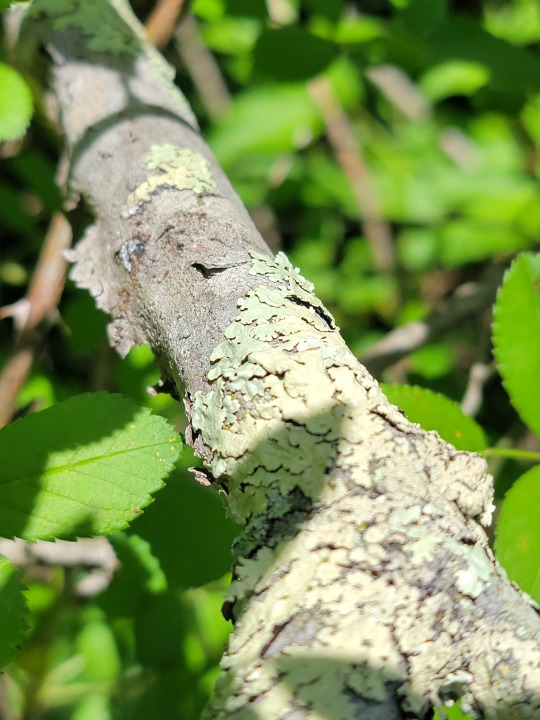


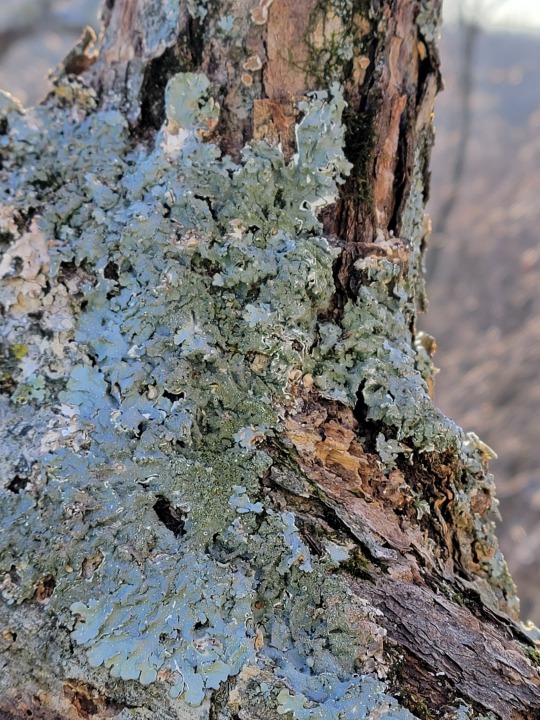

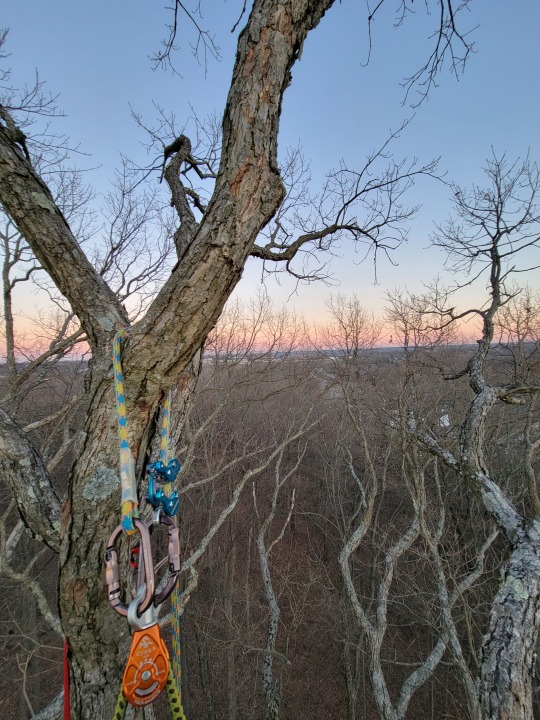

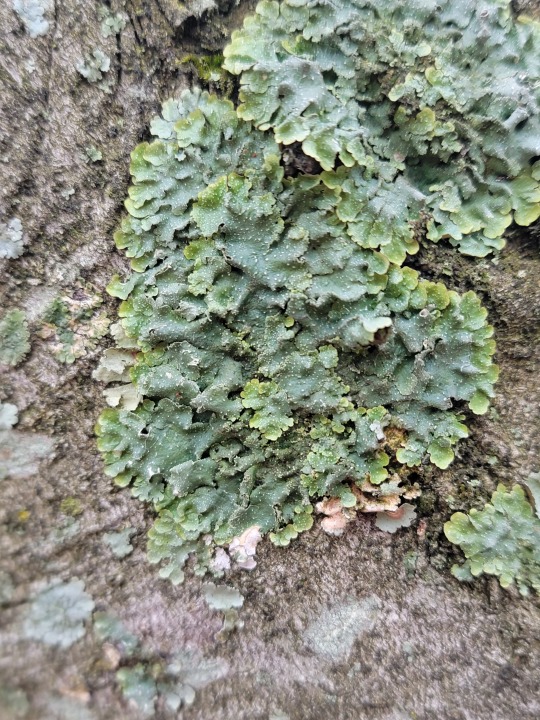
Some super common macro lichens in the midwest you can readily learn. Generalized to mainly wood surface and not super generalized on rock.
Common Greenshield Lichen, Flavoparmelia caperata
vs
Punctelia rudecta, and recent split Punctelia missouriensis (see those white speckled lobes. during full developement and we see a different colored isidiate core. this is why it’s commonly known as the rough speckled shield ) (this concept can be seen in the lower specimen.) (The upper though developes consistently less isidiate core and instead has overlapping squamulobes which gives it a mealy look.) (Called Mealy Speckled Shield lichen.)
What isn’t as common is large thallus mats with proper apothecia developement. Its like a light blue core if it’s the case unlike moon glow lichen which has a brown apothecia core and smooth axle bristle which looks green when hydrated and has an orange like tint when dry. imishaga doesn’t seem to produce apothecia or an isidiate core while rough speckled can produce both though the apothecia are supposed to be small like seen above on this Quercus muehlenbergii
the green shield will be smooth, baltimore green shield is a rock species where as smooth(rare) and common are both on wood, not an isidiate display, and fully same colored thallus wet or dry.
the bottom picture is the two colored thallus of rough speckled sheild without an isidiate core that i put water on to see if i could get hydrated colors.
#shield macro lichen#punctelia rudecta#punctelia#flavoparmelia#flavoparmelia caperata#lichen#ohio#botany#mycology#punctelia missouriensis#macrolichens#macrolichen#arborculture
17 notes
·
View notes
Photo

#stradaeasel Day 1 "Lots of Lichen" 8" x 10" oil on linen, 2020 I'm starting the new year off right painting Oregonian macro lichen on a #raymarart linen panel; great stuff! I hope 2021 is a productive and creative year for everyone! #stradaeaselchallenge #still life #originalart #pacificnorthwest #oilpainting #natureart #macrolichen #ceramic #artistsofinstagram https://www.instagram.com/p/CJiG3LED1U4/?igshid=dxj1k9qb1coa
#stradaeasel#raymarart#stradaeaselchallenge#still#originalart#pacificnorthwest#oilpainting#natureart#macrolichen#ceramic#artistsofinstagram
8 notes
·
View notes
Photo
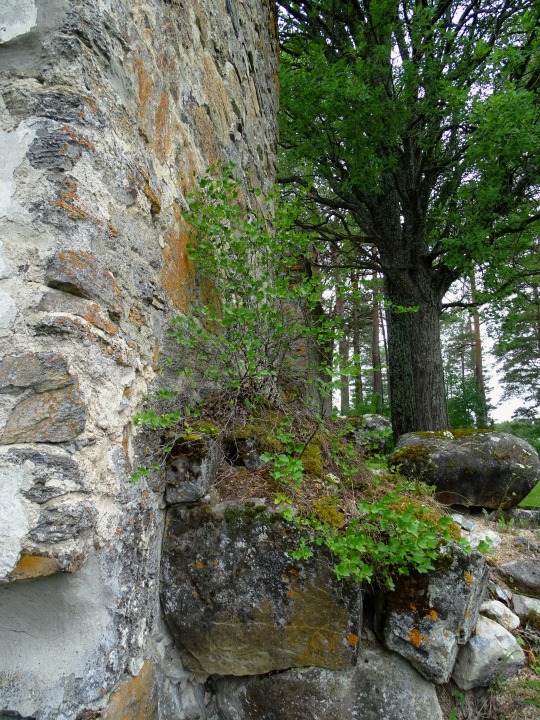








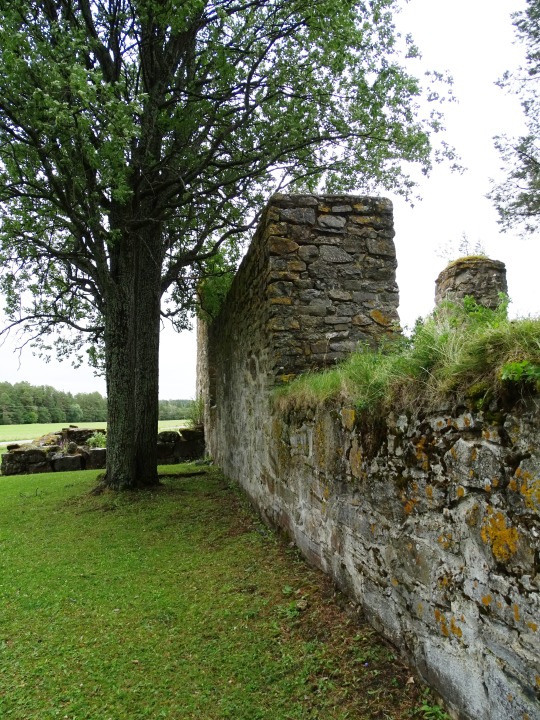
Sun Church Ruins, Sweden (No. 7)
A lichen is a composite organism that arises from algae or cyanobacteria living among filaments of multiple fungi species in a mutualistic relationship. Lichens have properties different from those of their component organisms. They come in many colors, sizes, and forms and are sometimes plant-like, but lichens are not plants. They may have tiny, leafless branches (fruticose); flat leaf-like structures (foliose); crust-like, adhering tightly to a surface (substrate) like a thick coat of paint (crustose); a powder-like appearance (leprose); or other growth forms.
A macrolichen is a lichen that is either bush-like or leafy; all other lichens are termed microlichens. Here, "macro" and "micro" do not refer to size, but to the growth form. Common names for lichens may contain the word moss (e.g., "reindeer moss", "Iceland moss"), and lichens may superficially look like and grow with mosses, but they are not related to mosses or any plant. Lichens do not have roots that absorb water and nutrients as plants do, but like plants, they produce their own nutrition by photosynthesis. When they grow on plants, they do not live as parasites, but instead use the plant's surface as a substrate.
Lichens occur from sea level to high alpine elevations, in many environmental conditions, and can grow on almost any surface. They are abundant growing on bark, leaves, mosses, or other lichens, and hanging from branches "living on thin air" (epiphytes) in rain forests and in temperate woodland. They grow on rock, walls, gravestones, roofs, exposed soil surfaces, rubber, bones, and in the soil as part of biological soil crusts. Different kinds of lichens have adapted to survive in some of the most extreme environments on Earth: arctic tundra, hot dry deserts, rocky coasts, and toxic slag heaps. They can even live inside solid rock, growing between the grains.
It is estimated that 6–8% of Earth's land surface is covered by lichens. There are about 20,000 known species. Some lichens have lost the ability to reproduce sexually, yet continue to speciate. They can be seen as being relatively self-contained miniature ecosystems, where the fungi, algae, or cyanobacteria have the potential to engage with other microorganisms in a functioning system that may evolve as an even more complex composite organism. Lichens may be long-lived, with some considered to be among the oldest living things. They are among the first living things to grow on fresh rock exposed after an event such as a landslide. The long life-span and slow and regular growth rate of some species can be used to date events (lichenometry).
Source: Wikipedia
#Sun Church Ruins#Sunne kyrkoruin#Sunne#Jämtland County#Sweden#Östersund Municipality#original photography#summer 2020#vacation#travel#ruins#architecture#I love places like this#so much to explore#woods#forest#tree#flora#free admission#tourist attraction#landmark#Scandinavia#Sverige#Northern Europe#wildflower#countryside#stone wall#lichen#overgrown
0 notes
Text
How a Guy From a Montana Trailer Park Overturned 150 Years of Biology
We here at the lichenloglichenblog encourage you to read this.
Biology textbooks tell us that lichens are alliances between two organisms—a fungus and an alga. They are wrong.
ED YONG, JUL 21, 2016 SCIENCE
In 1995, if you had told Toby Spribille that he’d eventually overthrow a scientific idea that’s been the stuff of textbooks for 150 years, he would have laughed at you. Back then, his life seemed constrained to a very different path. He was raised in a Montana trailer park, and home-schooled by what he now describes as a “fundamentalist cult.” At a young age, he fell in love with science, but had no way of feeding that love. He longed to break away from his roots and get a proper education.
At 19, he got a job at a local forestry service. Within a few years, he had earned enough to leave home. His meager savings and non-existent grades meant that no American university would take him, so Spribille looked to Europe.
Thanks to his family background, he could speak German, and he had heard that many universities there charged no tuition fees. His missing qualifications were still a problem, but one that the University of Gottingen decided to overlook. “They said that under exceptional circumstances, they could enroll a few people every year without transcripts,” says Spribille. “That was the bottleneck of my life.”
Throughout his undergraduate and postgraduate work, Spribille became an expert on the organisms that had grabbed his attention during his time in the Montana forests—lichens.
You’ve seen lichens before, but unlike Spribille, you may have ignored them. They grow on logs, cling to bark, smother stones. At first glance, they look messy and undeserving of attention. On closer inspection, they are astonishingly beautiful. They can look like flecks of peeling paint, or coralline branches, or dustings of powder, or lettuce-like fronds, or wriggling worms, or cups that a pixie might drink from. They’re also extremely tough. They grow in the most inhospitable parts of the planet, where no plant or animal can survive.
Lichens have an important place in biology. In the 1860s, scientists thought that they were plants. But in 1868, a Swiss botanist named Simon Schwendener revealed that they’re composite organisms, consisting of fungi that live in partnership with microscopic algae. This “dual hypothesis” was met with indignation: it went against the impetus to put living things in clear and discrete buckets. The backlash only collapsed when Schwendener and others, with good microscopes and careful hands, managed to tease the two partners apart.
Schwendener wrongly thought that the fungus had “enslaved” the alga, but others showed that the two cooperate. The alga uses sunlight to make nutrients for the fungus, while the fungus provides minerals, water, and shelter. This kind of mutually beneficial relationship was unheard of, and required a new word. Two Germans, Albert Frank and Anton de Bary, provided the perfect one—symbiosis, from the Greek for ‘together’ and ‘living’.
“That was the eureka moment. That’s when I leaned back in my chair.”
When we think about the microbes that influence the health of humans and other animals, the algae that provide coral reefs with energy, the mitochondria that power our cells, the gut bacteria that allow cows to digest their food, or the probiotic products that line supermarket shelves—all of that can be traced to the birth of the symbiosis as a concept. And symbiosis, in turn, began with lichens.
In the 150 years since Schwendener, biologists have tried in vain to grow lichens in laboratories. Whenever they artificially united the fungus and the alga, the two partners would never fully recreate their natural structures. It was as if something was missing—and Spribille might have discovered it.
He has shown that largest and most species-rich group of lichens are not alliances between two organisms, as every scientist since Schwendener has claimed. Instead, they’re alliances between three. All this time, a second type of fungus has been hiding in plain view.
“There’s been over 140 years of microscopy,” says Spribille. “The idea that there’s something so fundamental that people have been missing is stunning.”
The path to this discovery began in 2011, when Spribille, now armed with a doctorate, returned to Montana. He joined the lab of symbiosis specialist John McCutcheon, who convinced him to supplement his formidable natural history skills with some know-how in modern genetics.
The duo started studying two local lichens that are common in local forests and hang from branches like unruly wigs. One is yellow because it makes a strong poison called vulpinic acid; the other lacks this toxin and is dark brown. They clearly look different, and had been classified as separate species for almost a century. But recent studies had suggested that they’re actually the same fungus, partnered with the same alga. So why are they different?
To find out, Spribille analyzed which genes the two lichens were activating. He found no differences. Then, he realized that he was searching too narrowly. Lichenologists all thought that the fungi in the partnership belonged to a group called the ascomycetes—so Spribille had only searched for ascomycete genes. Almost on a whim, he broadened his search to the entire fungal kingdom, and found something bizarre. A lot of the genes that were activated in the lichens belonged to a fungus from an entirely different group—the basidiomycetes. “That didn’t look right,” says McCutcheon. “It took a lot of time to figure out.”
At first, the duo figured that a basidiomycete fungus was growing on the lichens. Perhaps it was just a contaminant, a speck of microbial fluff that had landed on the specimens. Or it might have been a pathogen, a fungus that was infecting the lichens and causing disease. It might simply have been a false alarm. (Such things happen: genetic algorithms have misidentified plague bacteria on the New York subway, platypuses in Virginia tomato fields, and seals in Vietnamese forests.)
But when Spribille removed all the basidiomycete genes from his data, everything that related to the presence of vulpinic acid also disappeared. “That was the eureka moment,” he says. “That’s when I leaned back in my chair.” That’s when he began to suspect that the basidiomycete was actually part of the lichens—present in both types, but especially abundant in the yellow toxic one.
“Toby took huge risks for many years. And he changed the field.”
And not just in these two types, either. Throughout his career, Spribille had collected some 45,000 samples of lichens. He began screening these, from many different lineages and continents. And in almost all the macrolichens—the world’s most species-rich group—he found the genes of basidiomycete fungi. They were everywhere. Now, he needed to see them with his own eyes.
Down a microscope, a lichen looks like a loaf of ciabatta: it has a stiff, dense crust surrounding a spongy, loose interior. The alga is embedded in the thick crust. The familiar ascomycete fungus is there too, but it branches inwards, creating the spongy interior. And the basidiomycetes? They’re in the outermost part of the crust, surrounding the other two partners. “They’re everywhere in that outer layer,” says Spribille.
Despite their seemingly obvious location, it took around five years to find them. They’re embedded in a matrix of sugars, as if someone had plastered over them. To see them, Spribille bought laundry detergent from Wal-Mart and used it to very carefully strip that matrix away.
And even when the basidiomycetes were exposed, they weren’t easy to identify. They look exactly like a cross-section from one of the ascomycete branches. Unless you know what you’re looking for, there’s no reason why you’d think there are two fungi there, rather than one—which is why no one realised for 150 years. Spribille only worked out what was happening by labeling each of the three partners with different fluorescent molecules, which glowed red, green, and blue respectively. Only then did the trinity become clear.
“The findings overthrow the two-organism paradigm,” says Sarah Watkinson from the University of Oxford. “Textbook definitions of lichens may have to be revised.”
“It makes lichens all the more remarkable,” adds Nick Talbot from the University of Exeter. “We now see that they require two different kinds of fungi and an algal species. If the right combination meet together on a rock or twig, then a lichen will form, and this will result in the large and complex plant-like organisms that we see on trees and rocks very commonly. The mechanism by which this symbiotic association occurs is completely unknown and remains a real mystery.”
Based on the locations of the two fungi, it’s possible that the basidiomycete influences the growth of the other fungus, inducing it to create the lichen’s stiff crust. Perhaps by using all three partners, lichenologists will finally be able to grow these organisms in the lab.
In the Montana lichens that Spribille studied, the basidiomycete obviously goes hand-in-hand with vulpinic acid. But is it eating the acid, manufacturing it, or unlocking the ability to make it in the other fungus? If it’s the latter, ���the implications go beyond lichenology,” says Watkinson. Lichens are alluring targets for ‘bioprospectors’, who scour nature for substances that might be medically useful to us. And new basidiomycetes are part of an entirely new group, separated from their closest known relatives by 200 million years ago. All kinds of beneficial chemicals might lie within their cells.
“But really, we don’t know what they do,” says McCutcheon. “And given their existence, we don’t really know what the ascomycetes do, either.” Everything that’s been attributed to them might actually be due to the other fungus. Many of the fundamentals of lichenology will need to be checked, and perhaps re-written. “Toby took huge risks for many years,” says McCutcheon. “And he changed the field.”
But he didn’t work alone, Watkinson notes. His discovery wouldn’t have been possible without the entire team, who combined their individual expertise in natural history, genomics, microscopy, and more. That’s a theme that resonates throughout the history of symbiosis research—it takes an alliance of researchers to uncover nature’s most intimate partnerships.
This part is from Lichenloglichenblog:
Lichen on!
21 notes
·
View notes